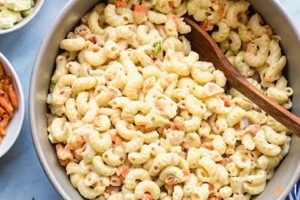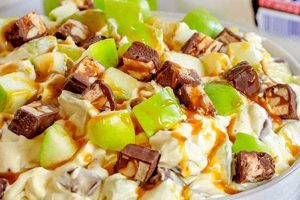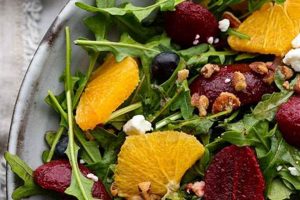Crisp lettuce provides the foundation for a vibrant and refreshing salad featuring a medley of Asian-inspired ingredients. These often include elements like shredded carrots, sliced cucumbers, mandarin oranges, edamame, red onion, and crunchy noodles or wonton strips. The dressing typically incorporates flavors like soy sauce, sesame oil, rice vinegar, ginger, and garlic, creating a balanced sweet, savory, and tangy profile.
Such salads offer a nutritious and flavorful meal option. The diverse ingredients contribute a range of vitamins, minerals, and antioxidants. The lighter dressing and fresh vegetables make it a healthier alternative to heavier salads, while the blend of textures and tastes provides a satisfying culinary experience. Variations exist across different Asian cuisines, reflecting regional preferences and ingredient availability, adding to the versatility of this dish.
This exploration will delve into variations of these salads, including specific ingredient combinations, dressing recipes, and tips for preparation and presentation. It will also touch upon the cultural influences and historical background that have shaped these culinary creations.
Tips for Crafting the Perfect Asian-Inspired Salad
Achieving optimal flavor and texture requires attention to detail. The following tips provide guidance for creating a truly exceptional salad experience.
Tip 1: Lettuce Selection is Key: Choose crisp, fresh lettuce varieties such as romaine, butter lettuce, or iceberg. Avoid wilted or bruised leaves. Different textures can add complexity, so consider a mix.
Tip 2: Ingredient Preparation Matters: Vegetables should be uniformly sliced or shredded for even flavor distribution and appealing presentation. Soaking sliced red onions in cold water can mellow their sharpness.
Tip 3: Dressing Application Technique: Toss the dressing with the salad ingredients just before serving to prevent the lettuce from becoming soggy. Start with a small amount and add more as needed.
Tip 4: Balancing Flavor Profiles: Achieve harmony by combining sweet, salty, sour, and spicy elements. The dressing should complement the other ingredients without overpowering them.
Tip 5: Protein Considerations: Enhance the salad with grilled chicken, shrimp, or tofu for a more substantial meal. Ensure the protein is properly cooked and cooled before adding it to the salad.
Tip 6: Garnish for Visual Appeal: Toasted sesame seeds, chopped cilantro, or crispy wonton strips can add visual interest and textural contrast.
Tip 7: Mindful Ingredient Storage: Store prepared ingredients separately and combine them just before serving to maintain freshness and prevent wilting.
By following these tips, one can elevate a simple salad into a delightful culinary creation.
These techniques can be further explored in the following sections, offering detailed recipes and variations.
1. Fresh, Crisp Lettuce
The foundation of any successful Asian-inspired salad lies in the choice of lettuce. Fresh, crisp lettuce provides a textural counterpoint to other ingredients and contributes a refreshing element crucial for balancing the overall flavor profile. Its structural integrity is essential for preventing a soggy salad and ensuring an enjoyable eating experience.
- Variety Selection:
Different lettuce varieties offer unique textures and flavors. Iceberg provides a satisfying crunch, while romaine hearts offer a slightly bitter edge and robust structure. Butter lettuce contributes a delicate sweetness and soft texture. A combination of varieties can create a more complex and interesting salad.
- Quality and Freshness:
The lettuce should be vibrant in color, free from blemishes, and exhibit a crisp texture. Avoid wilted or browned leaves. Proper storage is essential for maintaining freshness. Lettuce should be refrigerated in a crisper drawer and used as soon as possible after purchase.
- Preparation Techniques:
Proper handling ensures optimal texture and flavor. Wash lettuce leaves thoroughly and dry them completely before use. Tearing leaves by hand is often preferred over chopping, as it prevents bruising and browning. Chilling the lettuce before serving enhances its crispness.
- Role in the Overall Composition:
Fresh lettuce serves as more than just a base; it acts as a canvas upon which other flavors and textures are built. It provides a refreshing contrast to richer ingredients like dressings and proteins, creating a balanced and harmonious culinary experience.
The careful selection and preparation of fresh, crisp lettuce contribute significantly to the overall success of an Asian-inspired salad. It provides a refreshing foundation, a pleasing textural element, and a visually appealing component that elevates the dish beyond a simple combination of ingredients. Understanding the nuances of lettuce selection and preparation is essential for creating a truly exceptional salad.
2. Balanced Flavor Profile
A defining characteristic of successful Asian-inspired salads lies in the careful orchestration of a balanced flavor profile. This involves the harmonious interplay of sweet, sour, salty, spicy, and umami elements, creating a complex and nuanced taste experience that transcends individual ingredients. The balance prevents any single flavor from dominating, allowing for a more sophisticated and satisfying culinary outcome. This balance is crucial, particularly given the diversity of ingredients often incorporated into these salads.
Consider the interplay of a sweet element like mandarin oranges or a mango-based dressing with the salty notes of soy sauce or fish sauce. This dynamic is further enhanced by the introduction of sourness from rice vinegar or lime juice, and the potential addition of spice from chili flakes or ginger. Umami, the savory fifth taste, can be derived from ingredients such as toasted sesame oil, seaweed, or shiitake mushrooms, adding depth and complexity. A salad featuring grilled chicken, shredded carrots, crisp romaine lettuce, and a sesame-ginger dressing exemplifies this balance; the savory chicken and nutty sesame complement the sweetness of the carrots and the bright, peppery notes of the ginger, all brought together by the refreshing crunch of the lettuce.
Achieving this balance requires careful consideration of ingredient proportions and the interplay of contrasting flavors. It’s a dynamic process of adjustment and refinement, often involving subtle tweaks to dressing ratios or the inclusion of a balancing element. Overly sweet dressings can be tempered with a touch of acidity, while excessive spice can be mitigated by the addition of a cooling element like cucumber or yogurt. Understanding the principles of flavor balance allows for greater control over the final product, transforming a simple salad into a carefully crafted culinary creation. This understanding empowers one to not only follow recipes but also to adapt and improvise, creating unique and personalized variations.
3. High-Quality Ingredients
The success of an Asian-inspired salad with lettuce hinges significantly on the quality of its ingredients. Fresh, flavorful components elevate this dish from simple to exceptional. Subpar ingredients can detract from the overall experience, diminishing the intended balance and vibrancy. Utilizing high-quality ingredients ensures optimal flavor, texture, and nutritional value, contributing to a more satisfying culinary creation.
- Fresh Produce:
Lettuce should be crisp and vibrant, free from wilting or browning. Other vegetables, such as carrots, cucumbers, and bell peppers, should exhibit similar freshness, with firm texture and bright color. The use of ripe, in-season produce maximizes flavor and nutritional content. Sourcing produce locally, when possible, supports freshness. The difference between a freshly picked tomato and one shipped long distances is readily apparent in its flavor and texture.
- Premium Proteins (Optional):
If incorporating protein, quality remains paramount. Chicken, shrimp, or tofu should be fresh, not frozen, whenever feasible. Sustainable sourcing and ethical farming practices further enhance the quality and overall value. Grilled, marinated chicken or seared sesame-crusted tofu provides substantial protein and flavor, complementing the fresh vegetables. The protein choice significantly impacts the salad’s nutritional profile and culinary complexity.
- Authentic Flavor Enhancers:
Authentic sauces and seasonings are critical. High-quality soy sauce, rice vinegar, sesame oil, and ginger contribute distinct layers of flavor. Freshly grated ginger offers a more pronounced aroma and taste compared to pre-ground alternatives. The use of authentic ingredients elevates the flavor profile, distinguishing the salad from generic interpretations. The quality of these components directly influences the final taste and overall authenticity of the dish.
- Nuts and Seeds:
Nuts and seeds like sesame seeds, cashews, or almonds contribute texture, healthy fats, and subtle flavors. Freshly toasted nuts exhibit a more pronounced aroma and crunch. Toasting nuts before incorporating them into the salad enhances their flavor profile. The quality of these additions, even in small amounts, affects the overall textural and flavor complexity.
By prioritizing high-quality ingredients, the resulting Asian-inspired salad becomes more than a simple combination of components; it transforms into a carefully curated culinary experience. The interplay of fresh, vibrant flavors and textures creates a symphony of taste that highlights the nuanced characteristics of each individual ingredient. This commitment to quality elevates the nutritional value and overall satisfaction derived from the dish, reinforcing its potential as a healthful and enjoyable meal option.
4. Proper Preparation Techniques
Proper preparation techniques are essential for maximizing the flavor, texture, and overall quality of an Asian-inspired salad with lettuce. These techniques ensure that each ingredient contributes optimally to the final dish, creating a harmonious blend of tastes and textures. Careful attention to preparation details elevates the salad from a simple assemblage of components to a carefully constructed culinary creation.
- Vegetable Handling:
Precise cutting techniques are crucial. Uniformly slicing or shredding vegetables ensures even cooking (if applicable) and consistent flavor distribution throughout the salad. Julienned carrots and thinly sliced cucumbers offer both visual appeal and a pleasant textural contrast. Improperly cut vegetables can lead to uneven textures and an unbalanced eating experience.
- Lettuce Preparation:
Washing and drying lettuce thoroughly prevents residual dirt and excess moisture, which can dilute the dressing and make the salad soggy. Tearing lettuce leaves by hand, rather than chopping, minimizes bruising and browning. Crisp, dry lettuce provides a refreshing foundation for the other ingredients and enhances the overall textural experience.
- Dressing Emulsification and Application:
Proper emulsification of the dressing, ensuring that the oil and vinegar are well combined, creates a smooth, cohesive texture and prevents separation. Adding the dressing just before serving prevents the lettuce from becoming soggy and maintains the crispness of other ingredients. The correct timing of dressing application preserves the integrity of each component.
- Ingredient Incorporation:
The order in which ingredients are added can impact the final result. Delicate ingredients should be added last to prevent damage. Even distribution of ingredients throughout the salad ensures a balanced flavor profile in every bite. Consider layering textures and flavors for an enhanced culinary experience.
The meticulous application of proper preparation techniques significantly influences the overall quality and enjoyment of an Asian-inspired salad with lettuce. Attention to detail, from precise vegetable handling to the timing of dressing application, ensures that each ingredient contributes optimally to the final product. These techniques transform a simple salad into a carefully composed dish, highlighting the freshness and flavors of its individual components while creating a harmonious and satisfying culinary experience.
5. Visually Appealing Presentation
Visually appealing presentation significantly enhances the dining experience of an Asian-inspired salad with lettuce. Attractive arrangements elevate perceived freshness and flavor, stimulating appetite and creating a more positive overall impression. Consider the impact of vibrant colors, contrasting textures, and thoughtful plating on the diner’s perception. A thoughtfully arranged salad featuring a bed of crisp lettuce topped with artfully placed mandarin orange segments, edamame, and crunchy wonton strips generates greater anticipation and enjoyment compared to a haphazardly tossed mixture. This visual appeal communicates care and attention to detail, suggesting a higher level of culinary craftsmanship.
Strategic use of color plays a crucial role. The vibrant green of fresh lettuce provides a backdrop against which other colorful elements, such as red bell peppers, orange carrots, or the deep purple of red cabbage, can stand out. This contrast creates visual interest and reinforces the perception of freshness. Garnishes like toasted sesame seeds, chopped cilantro, or crispy fried onions add textural and color accents, further enhancing the visual appeal. Consider how a sprinkle of black sesame seeds against the vibrant green of lettuce creates a striking visual contrast, drawing the eye and stimulating appetite. The interplay of textures, from the smooth surface of edamame to the crunch of wonton strips, adds another layer of visual and tactile engagement.
Effective plating techniques maximize visual impact. Consider the use of white space on the plate, allowing the salad’s colors and textures to shine. Strategic placement of ingredients creates focal points and guides the eye across the composition. The height and layering of components add dimension and visual interest. Imagine a salad where the lettuce forms a base, topped with a colorful array of vegetables, and finished with a sprinkle of garnishes. This layered presentation adds depth and complexity to the visual experience. Achieving visual appeal requires not only quality ingredients but also an understanding of color theory, textural contrast, and thoughtful plating techniques. This attention to detail elevates the salad from a simple dish to a visually stunning and more enjoyable culinary experience.
6. Versatile Ingredient Combinations
The inherent versatility of Asian-inspired salads with lettuce stems from the wide array of ingredient combinations possible. This adaptability allows for customization based on dietary preferences, seasonal availability, and regional culinary traditions. A foundational element remains: crisp lettuce provides the canvas upon which a diverse range of flavors and textures can be built. This flexibility distinguishes these salads, offering a framework for creative culinary exploration.
Consider the interplay of textures. Crunchy elements like toasted nuts, crispy wonton strips, or water chestnuts contrast with the softness of avocado or the firmness of edamame. Flavor profiles expand through the incorporation of ingredients like shredded carrots, sliced cucumbers, mandarin orange segments, or thinly sliced red onions. Proteins such as grilled chicken, shrimp, or tofu can be added for a more substantial meal. The dressing further enhances versatility, with options ranging from a light vinaigrette to a creamy peanut sauce. A sesame-ginger dressing complements the subtle sweetness of shredded carrots and the earthiness of edamame, while a peanut-based dressing pairs well with grilled chicken and chopped peanuts. These combinations illustrate how ingredient choices influence the overall sensory experience.
Understanding this versatility allows for adaptation and innovation. Seasonal variations can be incorporated seamlessly. Summer salads might feature fresh berries and lighter dressings, while autumnal versions could include roasted root vegetables and heartier sauces. Dietary restrictions can be accommodated through ingredient substitutions; tofu can replace chicken for a vegetarian option, or a gluten-free tamari can substitute for traditional soy sauce. This adaptability ensures that the concept of an Asian-inspired salad remains relevant and appealing across diverse culinary contexts. The ability to personalize ingredients based on individual needs and preferences elevates this dish beyond a simple recipe, transforming it into a flexible and adaptable culinary concept.
Frequently Asked Questions
This section addresses common inquiries regarding the preparation and enjoyment of Asian-inspired salads with lettuce.
Question 1: What type of lettuce is best suited for an Asian-inspired salad?
Crisphead lettuce varieties such as iceberg, romaine, or butter lettuce provide a refreshing foundation. A combination of textures can enhance the overall experience.
Question 2: How can sogginess be prevented?
Adding the dressing immediately before serving is crucial. Thoroughly drying lettuce after washing also helps maintain crispness. Storing prepared ingredients separately and combining them just prior to consumption prevents premature wilting.
Question 3: What are common dressing ingredients?
Typical dressings incorporate soy sauce, sesame oil, rice vinegar, ginger, and garlic. Variations include the addition of honey, sriracha, or peanut butter for different flavor profiles.
Question 4: Can protein be added?
Grilled chicken, shrimp, tofu, or edamame are excellent protein additions. Ensure protein elements are cooked thoroughly and cooled before adding to the salad.
Question 5: How can nutritional value be maximized?
Incorporating a variety of colorful vegetables, such as bell peppers, carrots, and edamame, increases vitamin and mineral content. Adding nuts and seeds provides healthy fats and additional nutrients.
Question 6: How long can prepared ingredients be stored?
Prepared ingredients, stored separately and refrigerated in airtight containers, typically last for 2-3 days. However, consuming the salad as soon as possible after preparation ensures optimal freshness and flavor.
Understanding these key aspects contributes to successful preparation and heightened enjoyment. Attention to detail in ingredient selection, preparation methods, and storage practices ensures a satisfying culinary experience.
The following sections will provide specific recipe examples and further explore variations within this versatile culinary category.
Culinary Exploration of Asian-Inspired Salads with Lettuce Concludes
Exploration of the multifaceted nature of salads featuring lettuce as a base and incorporating Asian-inspired ingredients has reached its culmination. Key aspects, including the importance of fresh, crisp lettuce, the achievement of balanced flavor profiles, the utilization of high-quality ingredients, proper preparation techniques, visually appealing presentation, and versatile ingredient combinations, have been thoroughly examined. These elements contribute synergistically to the creation of a culinary experience that transcends the mere sum of its parts. Understanding these core principles empowers culinary enthusiasts to craft salads that are not only nutritionally sound but also aesthetically pleasing and deeply satisfying.
The potential for continued exploration within this culinary realm remains vast. Adaptation to seasonal ingredients, regional flavor preferences, and individual dietary needs offers endless possibilities for innovation and personalization. The fundamental principles outlined herein provide a framework for continued experimentation and the creation of unique and delightful culinary expressions. One is encouraged to embrace this framework, explore diverse flavor combinations, and elevate the simple salad to an art form.






